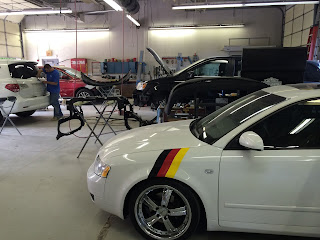Winter tires are the extreme of the three tires, and the best for living in a place like Minnesota. While you will fair alright with all season tires, for a driver inexperienced in heavy snowfall, we highly suggest the purchase of a true winter tire. They feature tread rubber, heavier depth with heavier patterns, and strong edges to cut into the snow.
- Tread Rubber: in all season and summer tires, tread will stiffen in cold temperatures inhibiting the proper traction. Winter tires see tread that is designed to remain flexible regardless of temperature.
- Tread Depth and Patterns: in winter tires, you see a more unique tread pattern or deeper divets in the tread to channel snow and slush, while also expelling water. Summer tires and all season tires have shallow tread and fewer patterns as it’s not an essentially part of driving in warmer weather.
- Biting Edges: Winter tires also have higher sipe densities, which is tiny slits in the tread providing higher traction on ice.
Typically when you purchase your vehicle and drive it off the lot, they’re outfitted with all season tires. All season tires were designed to provide year-round performance, making them an extremely popular choice. They are versatile and designed to function well on wet roads and in light winter driving. If you’re looking for tires that will allow you to drive year round without any extreme winters or storms, these are the ones you want.
All season tires are the compromise between winter and summer tires, meaning they have to compromise certain attributes. They don’t provide the same grip or handling of a summer tire, or the same ice capabilities of a true winter tire. Just like with your footwear, you’ll want the more extreme of the three based on what the conditions are outside. Nobody wants to wear flip-flops in a snowstorm or snow boots during a heat wave! The choice to purchase an all season tire should be made when you live in a moderate climate, free of extreme cold or ice, and free from extreme heat in the summer. In the event that your tires are ineffective in a storm, and you potentially ding up your vehicle, we’re here to help!






